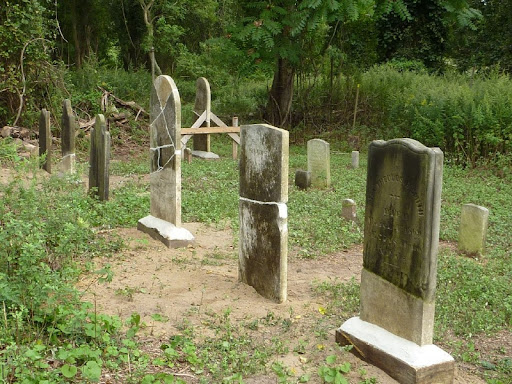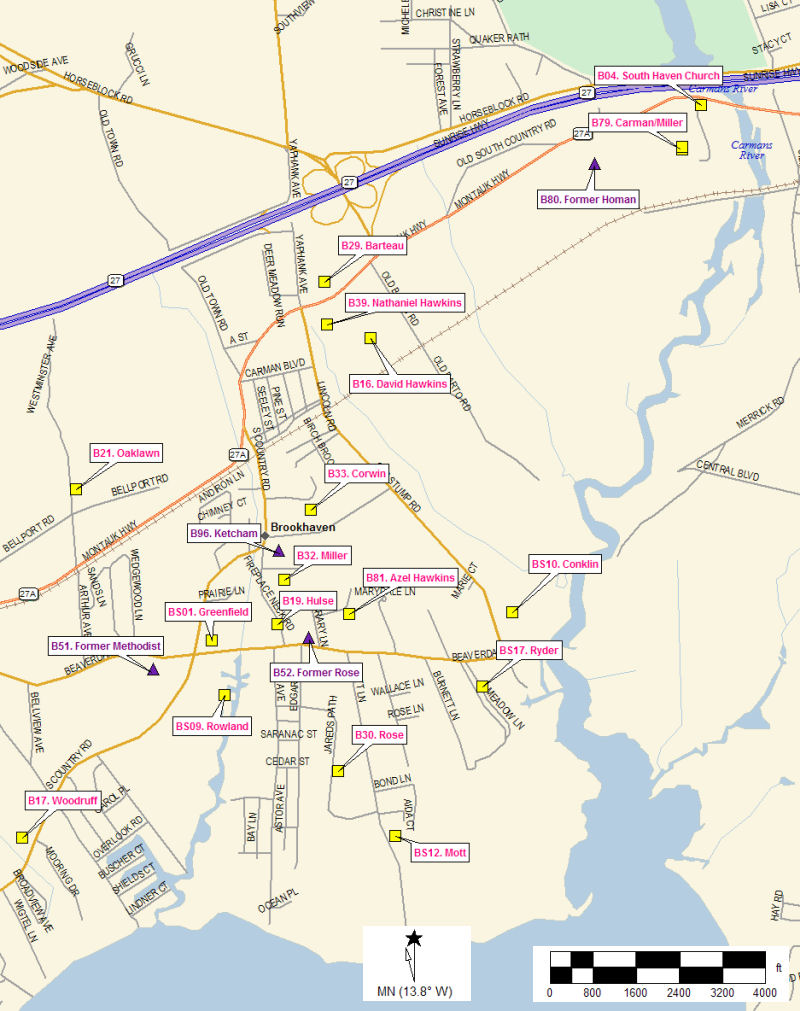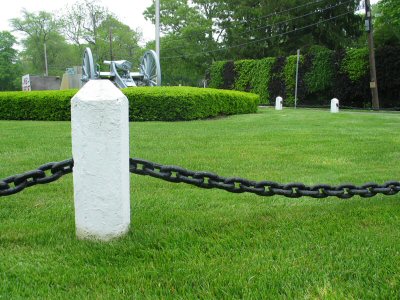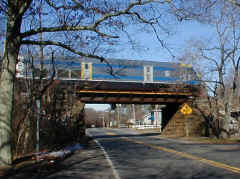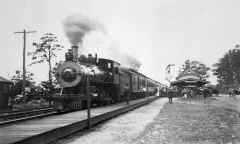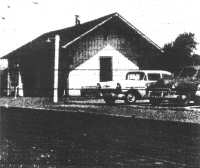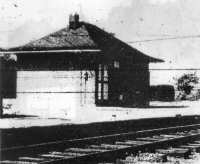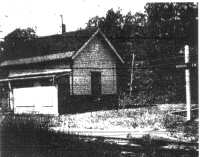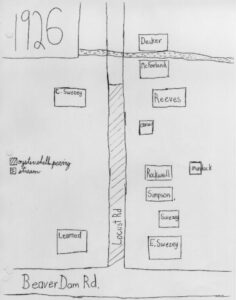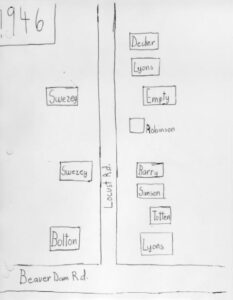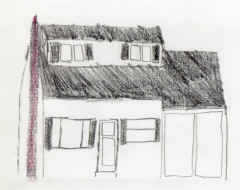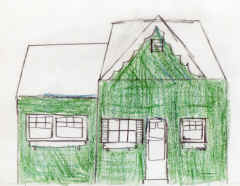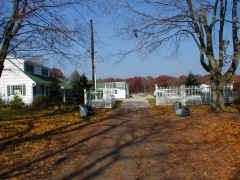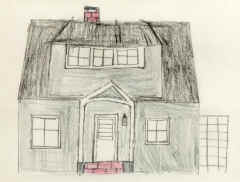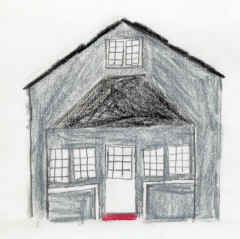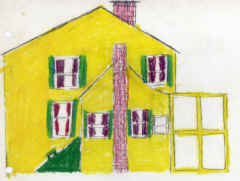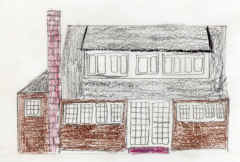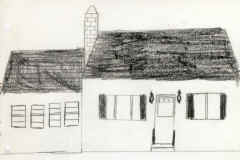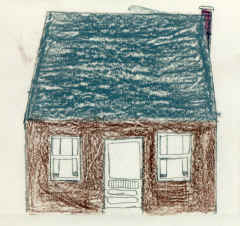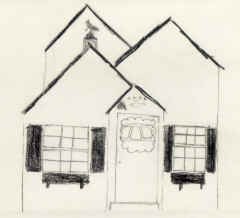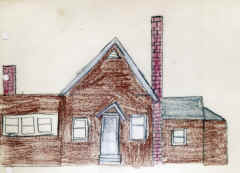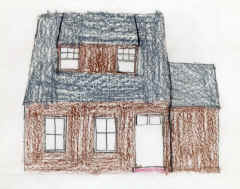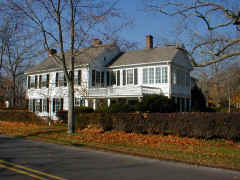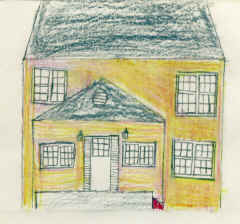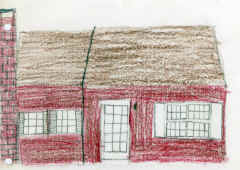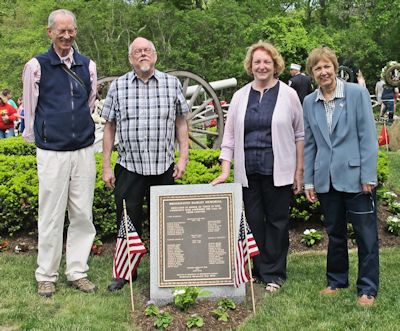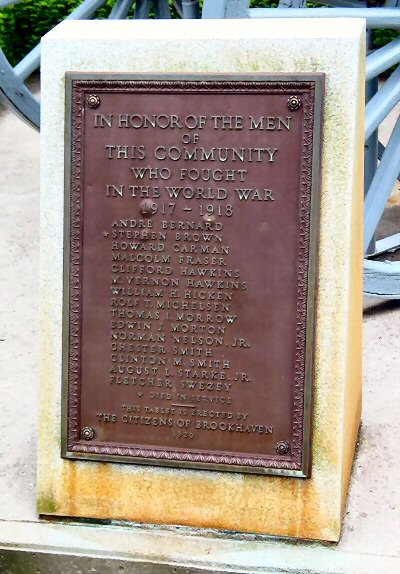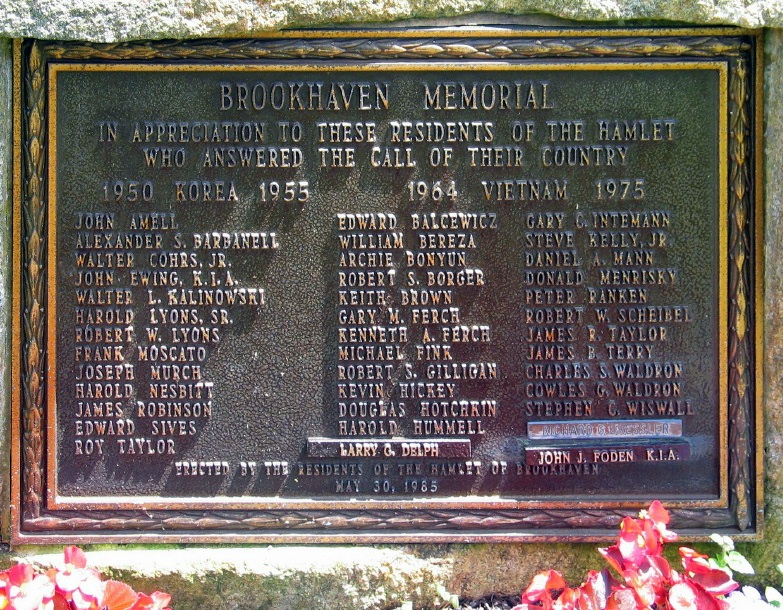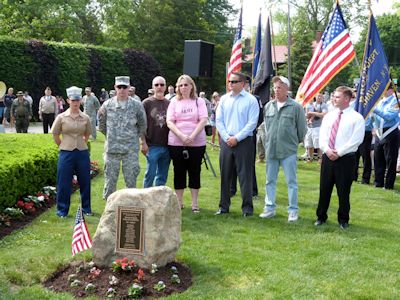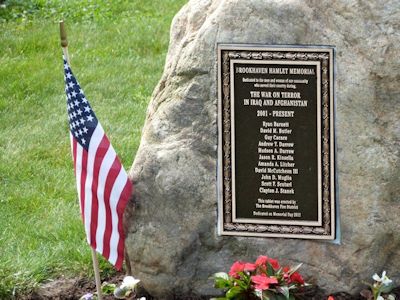A talk on the History of Brookhaven Hamlet, given by Janet Reddall and Alfred Nelson to the members of the Brookhaven Library Association on April 17, 1983 at the Annual Meeting of the Library Association.
Alfred Nelson – John (Binnington) asked me to talk about the river and the bay and things of that sort and I’m sure that Janet will talk about the social activities and the people and the houses.
Janet Reddall – Yes, the people and the houses.
AN– Yes. That would be about the size of it.
Well, I could say (here’s something of interest) that there were two ferries that ran from Brookhaven to Smith’s Point, which helped. And it was a pleasant place, run by a man named Howell and his family. Mrs. Howell must have been a very good cook. They had shore dinners. You’ve seen pictures of the Smith’s Point Hotel, I’m sure, in George Morse’s book. It’s on the table there. And it was a big rambling place and there was a boardwalk and bath-houses. There was a long stick dock, and there’d be a whole bunch of sail-boats there on Sunday and we’d go over all the time on the ferry.
There were two ferries that ran. One was run by a Captain Gerard. It was a large sloop, the Fanny Fern. There’s a picture of that also. And the other was the Woodmere, run by Captain Frank, Frank Smith. Frank Smith (anyone who ran a boat was called Captain in those days — Captain Frank, Captain Ed, and so forth.) Captain Frank had a big cat boat and he had the call through the boarding house, Mrs. de Arcas‘ boarding house, which was directly opposite us now. And that was the place the people came with the families, the annual two week vacation, and it was an awfully nice place. There was a big porch with rocking chairs and it was a happy place. However, Captain Gerard was more modern than Captain Frank. Captain Frank looked like a mountaineer. He had a black hat and old baggy clothes and a beard. But Captain Gerard was rather natty. He had a blue coat with brass buttons and a captain’s hat and his boat had a two-cylinder engine. Captain Frank had a one-cylinder engine. And they were rivals, no question about that. There were two docks running out where the public dock is now and there were two trips a day. They’d go in the morning and come back about noon-time and an afternoon trip. And on the trip on the ferry — I think the fare was about 25¢ and 15¢ for children, or something of that sort. Captain Gerard had a mate who did all the work, started the engine and tied the boat up and stuff of that kind, and raised the sail. It was a sloop rig. Captain Frank just depended on his passengers to run the boat. (Laughter) He didn’t have anybody who had to be paid. And Captain Ed — he had a little Sharpie boat — but…
Let’s see, I was thinking of something else. Oh, the Newey, Sam Newey, boat yard (that’s what makes me think) that Newey Lane used to be known as Eelpot Alley. That’s where several fisherman had their gear and everything. There were oh, a half a dozen baymen that made a living in the bay, fishing. And they used boats, they were called skiffs, and they were about 18, 19, 20 feet, cat-boat rig with open cockpits where they’d put barrels and things of that sort. And crabbing was a big business then. And, let’s see. They had a system of crabbing that was most interesting. You wonder how they could get barrels of crabs. They didn’t just have fish heads on the end of a line or anything. They had a system which was very clever. These boats were handy little sailors. They could carry about four barrels in each boat, two each side of the center board probably. They were not as big as sugar barrels. They were rather smaller. And the fisherman had a system where he’d build a line,[2] a crab-line. They’d chop up eels into sections maybe about a couple of inches long and then they’d tie them into this line maybe about every two or three feet with a knot, a clove hitch or something of that sort. Then they’d anchor this line out across the river, across the wind. At the mouth of the river they’d anchor it out with a buoy at each end. The line would be lying on the bottom. And then they had a thing on the boat, a seat with a large iron hook that hooked out of the side, and they usually covered it with a bicycle tire and they had a short handled scap net. And what they’d do, they’d sail up to the end of the line (this was across the wind if you get the picture) and they’d slack the sail off so the boat would just about move, and they’d put the line over the hook and sail down the line so the line would come up as they sailed over it, you see? And they would scap up the crabs into the barrel. And it was a real good idea. And on the freight house (they had a freight house at one time) on the platform I’ve seen a dozen or fifteen barrels of crabs ready to go to the city. And they had to chop little holes in the staves for air for the crabs to survive. And then there was a burlap top on the thing with a tag and off they went. And I suppose that getting four or five barrels of crabs was a good living. And they also did a lot of fishing for eels and other things. And that was about the… that was an interesting idea. I don’t know why somebody couldn’t do that right now, do the same thing.
JR – Are there still enough crabs here?
AN -Well, they vary. I don’t know. Sometimes there are, sometimes there’re not. There must have been plenty at that time.
What do you think? Think we ought to mention something of Mrs. de Arcas boarding house? You knew her, didn’t you?
JR – Yes, I did. Want me to start?
AN – Yes, I wish you to. Yes, please.
JR – Well, I was going to tell you a little bit first about how I got to Long Island. It was during the First World War, and two of my brothers — we came from Pittsburgh — and two of them had gone to France. And one was at Mitchell Field, here in Mineola. So we came and spent the first summer in 1918 at Bay Shore. And then we used to drive out here to Brookhaven. Father had a cousin, Mrs. Clyde Furst. Mr. Furst was secretary of the Carnegie Foundation in New York, and they built a house where the Hugh Browns live now. It looks like an old colonial house, but they built it before 1919 anyway. I would say sometime between 1910 and ’15, something like that. At any rate we liked it here in Brookhaven. That’s the way we first came out here and thought this was wonderful. So Father rented the house for the next three summers. And that’s the house the Wiswalls live in now, at the corner of Locust Street and Beaver Dam Road. And, let’s see what else I was going to tell you. I have to look at notes. Alfred, he can speak right off the cuff. (Laughter) And it was owned by Ellen Learned and she was a singer from New York. And if you think she taught singing. (I don’t know if people can hear me way back there.) At any rate, she and Miss Wagner lived there, I’m quite sure. She and Miss Wagner had sort of “palled up” together. It seems that those artistic and literary people sort of went in pairs, a lot of them down there. And they lived down Hawkins Lane at the time. Miss Wagner had a house down there. And Miss Learned, I believe, built a small cottage near it. You go down Hawkins Lane and then you go on a little shift to the left and it’s down near where the Stoenners live, down in there.
Voice from the audience – The Dolgers live in that house now, don’t they?
JR – Yes, I think the Dolgers live in one of them. That’s right. Yes.
Voice – And Miss Herman is in the other house.
JR – Who is that?
Miss Herman – I’m living in the present house now.
JR – Oh, you are! I see.[3]
Miss Herman – That was their first house. And then I believe they sold that piece of property and then they built the house where the Dolgers are now living.
JR – Yes. yes.
Well, Miss Learned apparently had rented. .. had inherited this house where the Wiswalls are, at any rate, and she rented it so Father signed up for three summers. So we were here the summers of 1919, ’20 and ’21. And so then the people were awfully friendly and interesting and Miss Mary Ford, who lived where Mrs. Tuthill, Dorothy Tuthill, lives now, on Beaver Dam Road, was the first one I believe who came to call. She was very enthusiastic and all, and her daughter… Mr. James L. Ford, he was a literary man and had been on the Herald, the literary critic. I guess, of the Herald newspaper in New York. And he’d written two books, one called Forty Odd Years in the Literary Shop, which I believe is on the shelves here, and Hot Corn Ike, which was about Coney Island. And he was an invalid at the time, but he liked to play bridge and Miss Ford liked to play bridge and so my parents got quite chummy with them and they played back and forth quite a lot. And then, across the road from us Miss Haskell had this little house. I have a picture of it here. I can pass it around later on if they want. And Miss Boughton lived together. Miss Haskell was the Head of the Art Department of Pratt Institute in Brooklyn and Miss Boughton was a photographer of some note and had a studio in the old Bartholdi Building in New York on Madison Square. And they came out and stayed weekends and summers in this house where the Phillips live now. It was right across from the Wiswall house. And, let me see, what else? Miss Learned and Miss Wagner. Miss Learned, I said, was a singer and taught singing. And Miss Wagner played the violin. Did she teach music too?
AN – I thought she did, yes.
JR – And she also made jewelry. And then there was Rea Irvin?
AN – Irvin, yes, an artist.
JR – Ray Irvin, down there where the Hansen house, the Mears and the Hansens had a house near where Miss Learned, down Hawkins Lane. And Ray Irvin drew the first .. he was an artist, and he drew the first cover for the New Yorker magazine.
AN -For the New Yorker magazine, yes he did.
JR – And it comes out every year.
AN – It was a dandy with a butterfly.
Voice – Eustace Tilley?
AN – Eustace Tilley, yes.
JR – And it’s on their February issue, I believe, every year.
AN – Every year.
JR – And then, next to us, on the west I guess, was the Burnett house. And Ike Burnett was a farmer there. I don’t know how many generations they’d been here. But he had three brothers and one was Thurman and we didn’t remember the other two names.
AN – Yes, there were two others.
JR – Two others.
Four brothers, and that’s where the Rowleys live now. And he was a nice old man. He farmed, and had horses of course and he owned the field across the street and farmed that with a horse, and back of his house too. And then he had a housekeeper called Mrs. Green and she was a colorful soul, who used to come over and chat at the fence with us when we were gardening along the fence line. She used to wear a little green plaid shawl and an old felt hat of Ike’s and we enjoyed her very much. Let’s see.
Oh, Mrs. Harrison lived over in the house…[4]
AN – It was the Bakers’.
JR – Yes, well, before the Bakers, Mrs. Harrison…
AN – They bought it. The Bakers bought it from Mrs. Harrison.
JR -That’s right. And that’s the house with the big white wall across from you, you know. And I remember Mrs. Harrison was very nice. She came over to see Mother in white gloves and Oh! she was very fancy. But…
Voice – Did they build that house, Janet, the Harrisons?
JR – Well, it was originally small. The Bakers moved something up to it for a kitchen, didn’t they?
AN – I think the Harrisons built it originally and the Bakers they’ve added to it. I think so.
JR – And then we made friends with the Post family, of course. And they had three daughters, and first of all Elizabeth Post, who is now Elizabeth Morrow, and Helen Morrow, who became Mrs. Ewing, married Mitchell Ewing , and they came down to see us. We got to know them and Helen Hubert. Of course, she was married and had about three or four children at the time and was living in the house Helen Maust has now. “Hillside,” wasn’t it?
Voice -“Hillcrest”
–
JR – “Hillcrest.” I went to the Southaven Church then; with my father and mother. They were Presbyterians and I was brought up in the Presbyterian Church. I
never joined, but I went with them. And that was of course out in Southaven, and the minister was the Reverend Allen . And then the Presbyterians had a little chapel here in Brookhaven, which most of you probably know as the Chapel House on the corner of South Country Road and Chapel Avenue.
AN – Yes.
JR – And George Morse used that later for a workshop and an antique place and clock shop.
And, let’s see what else is on here and out at the Southaven Church.
Mr. and Mrs. Post always went out there to church and the Augustus Floyds from Moriches, from Mastic, I should say. He’s a descendent of the original William Floyd, the signer, who came out there to church. And the Wallace Swezey family around. They lived on Stump Road. And this is Mr. & Mrs. Swezey and they had several daughters, Mrs. Rose, Mrs. Julian Rose. She’s still living. And her daughter Antoinette, down Hawkins Lane. And Let’s see, Wallace Keating lives down there. He’s a descendent of that family too. And there’s another. Oh, Shirley Sylvester, of course. Her mother, Mrs. Poole, was a Swezey. I don’t know that there’s more I wanted to say about the Southaven Church. Oh they had, in this chapel up here, they used to have Sunday night services because when it, in the old times, when it was too far to go to Southaven, and they had horses and all, they’d just have Sunday night chapel up here, and the Sunday morning service out in Southaven. Probably some of you remember when that Old Southaven Church was moved, on skids, right from Southaven up the South Country Road to its present location here at the corner of South Country Road and Beaver Dam. Later on, after I was married in 1925, I became an Episcopalian, at St. James Church. I married an Episcopalian and (laughter) in there. And I remember that Miss Learned used to sing in the choir, and your uncle Dem Nelson, and the church used to rock over there (laughter). Oh, the original property and the church had been given to St. James by the Ireland family.
I suppose you’ve all heard of the Ireland family, who had a big[5] home. You know where Mrs. Corrigan’s brick house is on Beaver Dam Road, and the bricks in that house came from the foundation of the Ireland house, which was sort of a Victorian house, I guess, with a brick basement and then you went up to a porch. The house was wooden and this wooden porch all the way around the house. A family by the name of something lived in the basement. I can’t think of their name, but they sold milk. I remember going down there once to get milk for somebody. Mrs. Morrow, I think, asked me if I’d go down to get milk. And the bricks were put into that Corrigan house, which is beautiful. It now belongs to the Scordamaglias. And that was down in the middle of what became the nursery — the Corrigan / Tiger Nursery. And the house was torn down, I guess, before that.
But the Irelands gave that property for St. James Church and in the deed, I guess, if it ever stops being a church it reverts back to the Ireland estate, which I don’t know if anybody could find an Ireland there or not. The organist in St. James was Mrs. Gwynne, who was the mother of Thurston Gwynne, the artist. And they lived in the little house across the street and I don’t know who… It’s on the corner of Fire Place Neck Road and Beaver Dam Road, right next to where the Nortons are. I don’t know who is living there now. I’m ashamed to say I’m not a good neighbor.
Miss Louise Carman used to come out there on her wheel. She lived in Southaven and she used to ride up on her bicycle to the church. I remember that distinctly. Alfred does too.
AN – Yes.
JR – Another thing I don’t think we mentioned was that, in the house where Mr. Binnington lives now, there was a Mrs. Carman and her son, Ken.
AN – That’s right.
JR – Do you remember him?
AN – I remember him. Yes, I do.
JR – And of course the river was named for their. .. for the Carman family.
AN – For the family, yes.
JR – Yes. Miss Carman lived out in Southaven and the river was out there, of course, and on the far side of the river was a house that Mr. and Mrs. Dominy lived in.
AN – Yes.
JR – Charlie’s grandmother.
AN – That’s right.
JR – That was old Mr. Jerry Dominy.
AN – Jerry Dominy, yes.
JR – And he was sort of a caretaker out there, wasn’t he, for some of that property on the river?
AN – Yes, the fishing club. What’s now the Southaven Park was a private club, a fishing club. They stocked it and he was superintendent there for many years. And he also had, after that, he had a coal and feed business up at the Brookhaven station. Brookhaven station had a siding and a freight house and there was quite a lot of traffic there.
JR – He had a big house, a big sort of a building where he stored coal.
AN – Yes.
JR – On the railroad tracks. Hold it! Hold it! We forgot Johnny Morton, too. You want to tell about Johnny Morton.
AN – He was the Justice of the Peace, I think. Well, I can think of several… (laughter).
That reminds me of something that Janet said that… the minister of our church, Mr. Allen. That reminds me of an incident which I think is amusing. One day, one time, he hired a boat from Selah Hawkins who had a large cat boat. He took the ladies of the church (I’m sure you weren’t there. It was before your time.) over to Smith’s Point. So it was a busy day there,[6] and the dock was loaded with boats — all on the lee side, naturally, they were sail boats. So Mr. Allen came blithely along with all. the ladies and he all the space on the windward side of the dock and he headed right for it. And people tried to wave them off. They shouted and yelled at them and BOOM! — he hit the stringer. Down came the mast all over (laughter). It was a shambles. So luckily no one was injured. But the ferry towed them back. I remember that. (laughter) I don’t know what Selah Hawkins said about the mast but I guess Mr. Allen must have paid for it, or whatever.
JR – The only story I can think of about Johnny Morton is that we always used to come back and forth on the train and had trunks and all. And nobody travels with a trunk anymore. (laughter) But he came to pick up a trunk from our house up here and it was in the morning. I don’t know, 10:00 o’clock anyway. My brothers were all back from France and one of them was asleep upstairs and he saw Johnny Morton going by his door, which is right at the head of the stairs, with this large trunk. And Mr. Morton wasn’t any higher than that (laughter). And he jumped out of bed with his pajamas and helped him down the stairs with it and, when he got to the front door he was going to take it out to… What did he carry the trunks in? That little jitney that he had?
AN – I guess so.
JR – He drove the only taxi around here too and used to meet all the trains. But, at any rate, when he got to the door Mr. Morton said, “You can’t come out in your pajamas.” (laughter) I don’t remember how they got the trunk out, but I think that Art probably took it on out to the… but that was another thing about it.
Oh, I wanted to tell about two families from Flushing who came here, who had summer homes. Your grandfather and Judge Fitch’s family, who had the home on the corner of Beaver Dam and Bay Road where the Petrettis live now, where we used to live. But your grandfather’s home was up opposite the…
AN – The Brook House.
JR – Opposite the Brook House, which wasn’t built then, of course.
AN – No, it wasn’t built, no.
JR – And I figured out — I was counting up — that you’ve had five generations of Nelsons in Brookhaven.
AN – I never thought of that (laughter), really.
JR – Well, I mean, you’re the third, and then there are two or three more, your children and grandchildren.
AN – Yes there are — grandchildren. That would be five, wouldn’t it?
JR – Yes.
AN – I never thought of that.
JR – And then the Fitches had the house that I said. He was a judge from Flushing, and Mrs. Fitch… This little book, I guess. … And that’s the house as it was when the Badettys were in it.
AN – Exactly. I remember that, yes.
NR – And the Fitches bought it from the Badettys. Not Petretti, Badetty. When the Badettys had it it was a fruit farm and a boarding house. And then Judge Fitch and his wife and two daughters, it was their summer home. And then the Reddalls bought it from Mrs. Fitch. And now the Petrettis are in it, so I see that there were only about five families who’ve lived in that house. And, of course before the Badettys… When the Badettys were in it all that fancy front was built which we tried to eliminate and make Colonial. This little book here will show the… If you want to come up later. You can pass it around.[7]
JR – As it was when… And this… And this postal is very precious. It shows the bridge. Maybe it ought to go with it, though. It shows the Beaver Dam bridge as it was before the… at that time and then it’s been changed when the hurricane of ’38 came in, of course. But it wasn’t like that when we were living there in the early 20s. It wasn’t like that picture.
Now let’s see. I think I’m almost through. Is that enough time? (laughter)
Voice – I would like to listen to you almost indefinitely.
JR – Can you hear me?
Voice – Yes, we can. We could hear you loud and clear. Mr. Nelson-
AN – Yes.
Voice – Do you have any more?
AN – Well, not other than people might have some questions that I could answer about some building or house or something that I might know about.
I’ll tell you something interesting. The river, the Carman’s River was originally called the Connecticut River, which you see the sign says Connecticut or Carman’s River. On the old maps it’s Connecticut, but Carman was a man, of course. He had a store at the head of the river where the crossing is now, that is, where the old Presbyterian Church was. And he had it named Carman’s River. I don’t know how he worked it but he did, anyway. He must have been a VIP or something.
But at the landing, down at the landing, Squassux Landing, you all must remember a large house that stood just to the north of the landing. It was later owned by the Michelsons. But back when a man named Lush who owned the house, and he was a crabby old fellow and he would extract three dollars or five dollars from everybody to put up a stake in the meadow to tie the boat up. And when the tide was high it’d be ankle deep getting down to the boat. However, Mr. Post quietly bought the property and let it be known that anyone in the Village could use the landing at no charge ever. And he built a little summer house and a slip. He had a small little Elko, I guess, cruiser. And he had a chauffeur and he also ran the boat. So subsequently the property was given to the Village Association, and it consisted of something about nine acres. We used to call it the Village Improvement Society. They held meetings in the old school house, which is pictured, the one there, the two story building was moved away. And they had monthly meetings, I guess. It was a lot of fun. We’d sit in the back of the place and listen to all the fun {laughter), swat mosquitoes and wrestle (laughter).
JR – I might add that my cousin Lowry, who always made great fun of his father’s being a Phi Beta Kappa and his intelligence and all that business, used to call that the Village Imp, I remember. I guess other people in the Village used to call it the Village Imp too.
Lowry used to be a mate on Captain Gerard’s boat, too. He was a good sailor, yes. The Fursts had two sons: Brading, who studied the jewelry-making, I remember, with Miss Wagner; then Lowry studied marine, went to a marine school. Where is that? Up at Fort Totten or some place like that…
AN – Yes, yes.
JR – … and became a mate on the, on the … not Navy, but merchant ships.
AN – Merchant Marine.
JR – Yes. And that picture of the.. .. This could go around too, if you want to. This is one that Miss Boughton painted. She was the photographer. Did I tell you about her yet?
Voice – Some.
JR – And then there’re some other pictures here that I thought were very interesting. Oh, this is the cottage, the house where we live now. It’s the, it was the old barn of the[8] Badetty house. Then it was made into a winter house by Captain Wardlaw, and now…
Voice – Do you know the house called “Blue Shutters“? Is that an old house?
JR – Yes. That was a house that Miss… I don’t know how old it was but Mrs. Chase, who was…
Voice – Ilka Chase?
JR – Ilka’s mother, and they used to come out there for vacation. Oh, we didn’t tell about Mrs. de Arcas’ boarding house, did I?
AN – No we . .. I just mentioned it.
JR – Well, Mrs. de Arcas’ boarding house, where the Munhofens live now… Of course the Minhofens built a brand-new house. They attracted a lot of people from New York — artistic and literary and other people came down there. And Mrs. Chase and Ilka, I believe, started there and then Mrs. Chase bought that place, and who was the other lady that came down? She was…
AN – Boughton, was it?
JR – No, Boughton was the photographer up the street here, but there was another one. I can’t think of her name, Miss Somebody, and she added on to that cottage, the “Blue Shutters”.
Mrs. Munhofen – We found silver utensils that they had at the boarding house, yes, in the ground, and bits and pieces of the plates and bowls. It was blue and white.
AN – Kitchen middens.
JR – She set a very good table. She was noted for her food. And her daughter-in-law, Mrs. Amy de Arcas, who lived up around South Country Road, about
where the old post-office on the other side of the road, up near where Mr. Comstock is now living, she also served good meals [house]. We used to go up there after Mrs. de Arcas’ house…
Voice – That burned down.
JR – The boarding house.
Voice – About 45 years ago.
AN – Yes, it did.
JR – I used to take her with my family to market. We had to market mostly in Patchogue. We could get a few things in Bellport. And oh, we didn’t tell about the store there across the street where you live.
AN – Yes.
JR – There was a little store there. But anyway Mrs. de Arcas would always love a ride to Patchogue, and when we came back we were just like a truck full of, you know, vegetables and fruit and all. The car was packed. She always liked to go up there. And then this little store over where the Nelsons live now was called… We always called it the Store House. Did you call it the Store House?
AN – No. It was run by a man named Albin, who built the store originally, and it changed hands after a while but he ran it for a long time.
JR – I see.
Voice – Is that corner still zoned for business (laughter)? Can we have a 7-11 there or something?
AN – No. The Valentine Store was the principal store and the post office. Valentine was the post master and that was the headquarters at mail time. When the mail would come in on the 6:00 o’clock train or thereabouts, and Mr. Barnes had a little horse and buggy. He’d bring the mail to the post office. And they’d[9] “overhaul the mail” they called it. Everybody’d be there to get the mail. No RFD then, of course, and there were bicycles and wagons and cars and everything. It was a regular meeting place every night at the General Store and post office.
JR – That was up on the main road, on South Country Road.
AN – Yes, and Helen, by the way Bumpsteads lived in the house that you live in now. Ad Bumpstead was the Constable and he had a star on his vest (laughter). He really was an important man.
Voice – That was when it was a little old salt box down by the road.
AN – It was down by the road. They moved it back.
Voice – And then they moved it back. (Your house was down by the road? Um hum.)
Voice – Alfred, you went through the Brookhaven School. Tell us what school life was like.
AN – Well, it isn’t exactly that. One year my family came down early and I was in the school for I guess about a month, at the most, in this old schoolhouse, the one that was moved away and I wasn’t very attentive I’m sure, but… I think I rang the bell two times when I shouldn’t have. But it had a pot belly stove and it really was awful nice – two rooms, upstairs and down. And I was only there for about a short time, I remember.
JR – It’s down near your road, isn’t it now?
AN – Yes.
Voice – I live in it.
AN – Oh, you do? Do you really?
Voice – It was moved by barge.
Voice – Yes, my wife Lorelei and I live in it.
AN – Mr. Higgin moved it. He moved it and the belfry was used as a beach sort of a little house or whatever. It washed away in the hurricane. It was a gazebo on the beach.
Voice – About how many students were there?
AN – Oh, it’s hard to recall but there weren’t too many, about maybe 35 or 40 at the most. There were two rooms. Mr. Johnson was the Principal and Mrs. Johnson taught too in the school. I’m not sure. That’s the house that you’re in, the Jolnson house.
Voice – Al, wasn’t there some story that George Miller‘s house was built on a barge?
AN – Yes, George took my brother Norman down and showed it to him one time. It was many years ago. When Miller built the house, you’re familiar with it. It’s right by the square there, the old Miller house. Low ground it was. And he had, must have been some shipwrights to do the job. They built essentially a barge in the ground and then built the house on top of the barge. It was heavily pitched or whatever it was, and it lasted for many years. I think the Miller house was built… George told my brother it was built in about 1825 and the barge lasted. Finally it rotted of course. They must have shored it up in some manner to preserve it. An interesting idea.
The house that… the farm that my grandfather bought that’s a farm that was built some time later, 1935 [sic, probably meant 1835] or thereabouts, after the Miller house. A real old farm house, and it was added to. A large extension was built on it so it disappeared, the old farmhouse, really.
JR – Your grandfather probably put that pretty portico on the front door.
AN – That is so, yes, yes.[10]
JR – By the way, the house that the Sachs have up here had a lovely front entrance there.
AN – The Rose house, you mean? The one with the…
JR – Yes, the old Rose house.
AN – That’s one of the oldest houses.
JR – Have they kept the dimensions of that, I wonder?
AN – I hope they did.
JR – I hope so, because they hadn’t put it back on.
AN – No, they hadn’t.
JR – Of course, they put an awful lot of work into that house, really. There are other pictures up here if anyone wants to look. Oh, we had a movie over on the beach, probably you all heard about that. I think the are some pictures someplace of that. I just picked up a couple of these albums.
Voice – There was a sheik in it, wasn’t there?
AN – It was a desert scene.
Voice – Yeah, because we have one too.
Voice – Oh, is that the one that’s in this little one?
AN – It probably is in some…
Voice – Because there were palm trees and I didn’t think there were any palm trees there.
JR – That was the girl. Was her name Gene Tierney or something like that?
Voice – There was a Gene Tierney.
JR – What?
Voice – There was a Gene Tierney, actress.
JR – Well, I think she was in it and Conway Tearl, and their pictures are there. I don’t know who this other one is. Over here…
AN – They brought over camels and had Arabs (laughter), the whole works.
JR – They built an oasis. There are more pictures around someplace. Does anybody have anything else there? I think he rented that boat and that was my canoe. We used to just go down there and tie up to space, down on the Squassux Landing.
AN – That’s right.
JR – And Mr. Post never charged anybody anything, I don’t think.
AN – No.
JR – So, I guess that’s about it.
AN – Yeah.
JR – Well, we’ve had ourselves an afternoon.
Voices – It was wonderful, interesting, fantastic.
Connie Goodzeit – I think if there are any questions while we’re having some refreshments, you can talk a little bit. I want to thank you very much for enriching our lives.
JR – Oh, really? (Applause)
